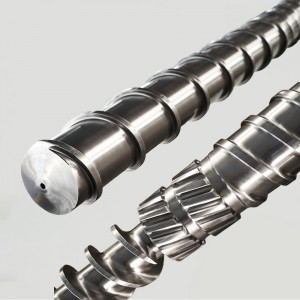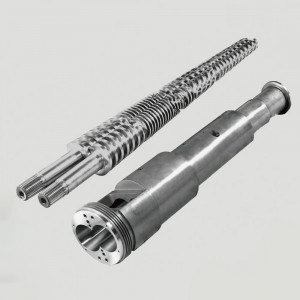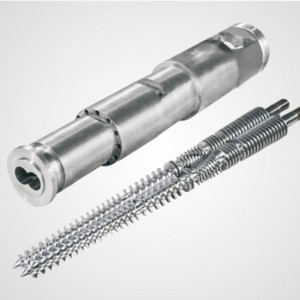
The Screw barrel for Blowing plays a vital role in producing high-quality films. Its advanced design ensures materials melt, mix, and flow efficiently during the extrusion process. Whether used in a Single Screw Plastic Extruder or a Blow Molding Screw Barrel, it helps manufacturers achieve consistent results. With innovations like the Single Screw Barrel For Blowing Moulding, film durability and appearance reach new heights.
Understanding Film Quality Challenges
Blown film production is a complex process, and achieving consistent quality can be challenging. Manufacturers often face issues like defects, durability concerns, and inconsistent film properties. Let’s explore these challenges in detail.
Common Defects in Blown Film Production
Defects in blown film production can disrupt operations and lead to wasted materials. Some of the most common issues include:
| Common Defect | Description |
|---|---|
| Bubble Instability | Problems with the extruded bubble, such as breaks or an unstable frost line. |
| Gauge Variation | Uneven film thickness caused by misaligned die gaps or irregular flow distribution. |
| Interfacial Instability | Distortions between layers, often due to shear stress differences during extrusion. |
These defects can result in films that fail to meet industry standards. For example, bubble instability can cause uneven surfaces, while gauge variation impacts the film’s strength and appearance. Using advanced equipment like the Screw barrel for Blowing helps minimize these issues by ensuring precise resin processing and uniform melt distribution.
Durability and Strength Issues in Films
Durability is critical for films used in packaging, agriculture, and industrial applications. Weak films can tear easily, compromising their functionality. Strength issues often arise from poor resin mixing or uneven additive distribution during extrusion.
The Screw barrel for Blowing addresses these problems with features like a barrier mixing section. This section ensures polymers and additives blend evenly, creating a strong and durable film. Manufacturers also benefit from high compression ratios, which improve melt homogeneity and stabilize the bubble during production.
Achieving Consistency and Stability in Film Properties
Consistency is key to producing reliable films. Variations in thickness, appearance, or mechanical properties can lead to customer dissatisfaction. Achieving stability requires careful control of the extrusion process.
Manufacturers have improved film consistency by:
- Matching process conditions to resin and equipment
- Tuning temperature profiles
- Maintaining die lips and air rings regularly
Other strategies include optimizing temperature and pressure control, enhancing die design, and strictly monitoring raw material quality. These adjustments lead to better bubble stability, higher product quality, and increased production efficiency.
By integrating advanced technologies like the Screw barrel for Blowing, manufacturers can achieve consistent film properties while reducing waste and defects.
The Role of Screw Barrel for Blowing Design

Grooved Feed Design for Efficient Resin Processing
The grooved feed design is a game-changer in the blown film extrusion process. It features deep grooves and flights that guide the resin through the barrel with precision. This design ensures the resin melts evenly and flows smoothly, which is essential for producing high-quality films.
Why does this matter? Uneven melting can lead to defects like gauge variation or weak spots in the film. The grooved feed section prevents these issues by optimizing the resin’s journey from solid to molten state. It also improves the feeding efficiency, reducing energy consumption and enhancing overall productivity.
Manufacturers rely on this design to handle a variety of materials, including PP, PE, LDPE, and HDPE. By ensuring consistent resin processing, the grooved feed design plays a vital role in achieving superior film quality.
Barrier Mixing Section for Uniform Melt and Additive Distribution
The barrier mixing section is where the magic of uniformity happens. Positioned near the end of the screw, this section ensures that polymers and additives blend seamlessly. This is crucial for achieving films with consistent properties, whether it’s strength, clarity, or thickness.
Studies have shown how effective this section is in improving melt quality. For instance, a statistical analysis revealed the following:
| Evidence Description | Key Findings |
|---|---|
| Correlation between melt quality and SPI | The study shows that as the standard deviation of temperature and material homogeneity decreases, the SPI increases, indicating better homogenization of the melt. |
| Importance of thermal homogeneity | Consistent thermal performance across the die cross-section is crucial for uniform flow behavior, which affects dimensional accuracy. |
| Evaluation of screw configurations | The study compares standard deviations across different screw configurations to assess thermal homogeneity, aiming for the lowest standard deviation. |
This data highlights how the barrier mixing section ensures a uniform melt and even additive distribution. By reducing temperature variations and improving material homogeneity, it helps manufacturers produce films that meet the highest standards.
High Compression Ratio for Bubble Stability and Viscosity Control
Bubble stability is a critical factor in blown film production. An unstable bubble can lead to defects like uneven surfaces or interfacial instability. The high compression ratio in the screw barrel addresses this challenge by improving melt homogeneity and controlling viscosity.
How does it work? The high compression ratio increases the pressure within the barrel, ensuring the resin melts thoroughly and flows uniformly. This not only stabilizes the bubble but also enhances the film’s mechanical properties.
Manufacturers benefit from this feature by achieving better control over the extrusion process. It allows them to produce films with consistent thickness, improved strength, and a flawless appearance. The Screw barrel for Blowing, with its high compression ratio, is an indispensable tool for achieving these results.
Key Benefits of Optimized Screw Barrel for Blowing

Enhanced Film Strength and Durability
Optimized screw barrels significantly improve the strength and durability of blown films. They ensure polymers and additives mix evenly, creating a uniform melt that enhances the film’s mechanical properties. This uniformity boosts tear resistance and elasticity, making the films more reliable for demanding applications like packaging and agriculture.
- Key Improvements:
- 90% reduction in defects like pinholes
- Enhanced tear resistance
- Improved elasticity
These benefits mean manufacturers can produce films that withstand stress and maintain their integrity over time. Whether it’s heavy-duty packaging or protective agricultural films, the Screw barrel for Blowing ensures the final product meets high durability standards.
Improved Consistency in Thickness and Appearance
Consistency is critical in blown film production. Uneven thickness or surface imperfections can compromise the film’s functionality and aesthetic appeal. Optimized screw barrels address these issues by maintaining precise control over resin flow and melt distribution.
Tip: Consistent thickness not only improves the film’s appearance but also ensures uniform strength across its surface.
Manufacturers using advanced screw barrel designs achieve films with smooth surfaces and uniform dimensions. This consistency reduces the likelihood of customer complaints and enhances the overall quality of the product.
Reduction in Defects and Waste During Production
Defects like pinholes, gauge variation, and bubble instability can lead to wasted materials and increased production costs. Optimized screw barrels minimize these issues by ensuring efficient resin processing and stable bubble formation.
By reducing defects, manufacturers save time and resources while improving production efficiency. Less waste means lower costs and a more sustainable manufacturing process. The Screw barrel for Blowing plays a pivotal role in achieving these outcomes, making it an essential tool for modern film production.
Real-World Applications of Screw Barrel for Blowing
Packaging Film Production
Packaging films are everywhere, from food wraps to industrial liners. Manufacturers need films that are strong, thin, and visually appealing. The Screw barrel for Blowing plays a key role in achieving these qualities. Its advanced design ensures precise resin processing, resulting in films with consistent thickness and enhanced puncture strength.
Studies have shown how adjustments in barrel temperature, screw speed, and feed rate impact film performance. For example:
| Parameter | Effect on Performance |
|---|---|
| Barrel Temperature | Higher temperatures lead to thinner films and increased puncture strength up to 145°C. |
| Screw Speed | Increased screw speed improves puncture strength, especially at higher barrel temperatures. |
| Feed Rate | Minimal effect at low settings, but significant increase in puncture strength at high settings. |
These findings highlight how manufacturers can optimize their processes to produce packaging films that meet industry demands. With the Screw barrel for Blowing, they gain better control over film properties, ensuring reliable and high-quality results.
Agricultural Film Applications
Agricultural films protect crops, retain moisture, and block harmful UV rays. Weak or defective films can compromise crop yields. The Screw barrel for Blowing addresses these challenges by producing durable films with uniform thickness and fewer defects.
Manufacturers using the JT series single screw barrel have reported significant improvements in agricultural film production. Issues like pinholes and uneven thickness have decreased, ensuring films perform better in harsh outdoor conditions. These advancements help farmers maintain moisture levels and shield crops from UV damage, ultimately boosting agricultural productivity.
Specialty Films for Industrial Use
Industrial applications demand films with unique properties, such as high heat resistance or chemical stability. The Screw barrel for Blowing enables manufacturers to create specialty films tailored to these needs. Its barrier mixing section ensures even additive distribution, allowing for precise customization of film properties.
For example, films used in construction require exceptional durability and tear resistance. The high compression ratio of the screw barrel enhances these qualities, making the films suitable for demanding environments. By leveraging this technology, manufacturers can produce specialty films that meet the rigorous standards of industrial use.
The Screw barrel for Blowing ensures consistent film quality by tackling defects, improving durability, and stabilizing properties. Its advanced design processes resin efficiently, producing stronger, more reliable films. Industries like packaging, agriculture, and industrial manufacturing rely on these innovations to meet their demanding needs. This technology truly transforms modern film production.
FAQ
What materials can the Screw Barrel for Blowing process?
The Screw Barrel handles PP, PE, LDPE, and HDPE. Its design ensures efficient melting and mixing for consistent film quality across these materials.
How does the grooved feed section improve production?
The grooved feed section optimizes resin flow and melting. It prevents uneven processing, reduces defects, and boosts productivity during blown film extrusion.
Can the Screw Barrel be customized for specific needs?
Yes! Manufacturers can add features like melt pressure sensors or temperature controls. These options enhance precision and meet unique production requirements.
Post time: Jun-03-2025
